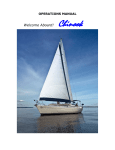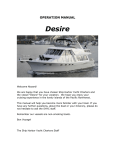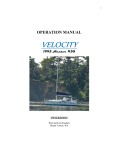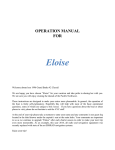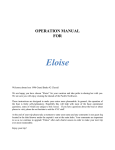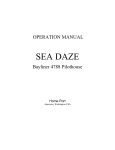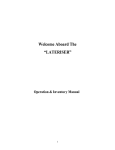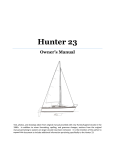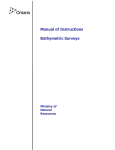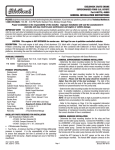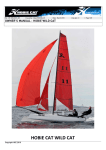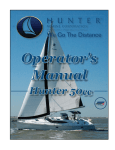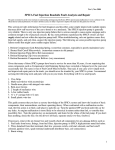Download Sienne Jeanneau International 50 Instruction manual
Transcript
Jeanneau International 50 SIENNE OPERATION MANUAL Welcome Aboard! We are happy that you have chosen Ship Harbor Yacht Charters and the vessel, Sienne, for your vacation. We hope you enjoy your cruising experience in the lovely islands of the Pacific Northwest. This manual will help you become more familiar with your boat. If you have any further questions, about the boat or your itinerary, please do not hesitate to ask the SHYC staff. Remember our vessels are non-smoking boats. . Bon Voyage! The Ship Harbor Yacht Charters Staff 1 TABLE OF CONTENTS Boat Operation Engine Inspection Start-Up Shutdown Getting Underway Cruising Docking Fueling Boat Electrical A.C. (Shore) Power Inverter D.C. (House) Systems Batteries Sanitation System Marine Toilet Holding Tank(s) Y-Valve Water Systems Fresh Water Tanks Fresh Water Pump Hot Water Shower Galley Propane Refrigeration/ Freezer Stove/ Oven Heating Systems Diesel Heater (DC) Electric Heater Electronics VHF Radio Auto Pilot Tridata Wind System GPS/Plotter DVD/CD Stereo AM/FM Radio Anchoring Sails and Rigging BBQ Dinghy/Outboard Other Notes Safety Precautions Bilge Pumps Engine Spares Crabbing Serial/Part Numbers Thru-Hull Diagram Fill and pump out diagram Page 3 4 5-6 6 7 8 9 9 10 11 14 15 2 BOAT OPERATION Engine Inspection Remember your “WOBBS” every morning. (Water (Coolant), Oil, Bilges (Inspect and Pump-out), Belts, and Sea Strainer. Check the level of COOLANT in the expansion tank. Check the level of your engine oil with the dipstick. Your dipstick is located on the port side of the engine block. Look at the etch mark on the dipstick that indicates proper level. DO NOT OVERFILL! Fill only if oil level is below the ½ mark. Check the general condition of the hoses and belts. Ensure the RAW WATER THRU-HULL is OPEN! (Lever position in-line with valve). Check the sea strainer for debris. If necessary, close the thru-hull, open the strainer lid, clean out debris, and reassemble. REOPEN THE THRU-HULL! Start Up SIENNE has a 90 hp Perkins diesel engine with a 3 bladed prop. There is an ignition, throttle and transmission control in the cockpit. The vessel cruises at 1800 rpm to a speed of 7.5 knots depending on water conditions. Running your engine much above 2000 will burn a lot more diesel with very little gain in boat speed. The boat has a definite prop walk to port in reverse with little effect in forward. When in reverse, be careful to keep a firm grip on the wheel. Use only low rpms in reverse. To start engine: Place transmission in the neutral position by placing the shift arm in the straight-up position with the red button depressed. Turn the ignition switch on and leave on while engine is running. Your oil and temperature alarms will sound. Push the ignition button (~ 1/2" diameter) in. The engine should start immediately. Depress the red button on the throttle and increase the rpm to 1100 to clear the warning lights and then back the throttle to 1000 rpm. Immediately check for water exiting the exhaust at starboard side aft. This is an indicator that the thru-hull is open and that water is keeping the engine cool. Do not hold the ignition key in for more than 5 seconds at a time. If the engine does not start the first time, wait about 15 seconds before trying again. NEVER TURN OFF THE KEY WHILE ENGINE IS RUNNING! After the engine starts, warm it up at about 1000 rpms for about 5 minutes. Observe that no warning lights are illuminated and no alarms are sounding. If so, shut down the engine and assess the situation for a potential problem. (Note: Was there a lack of water exiting with exhaust? Are thru-hulls open and debris cleared from sea-strainer? If a problem continues to occur, call SHYC Service.) 3 Shut Down Before shutting the engine down, let it cool for 5 minutes at idle and transmission in neutral. Turn off the engine by lifting the "Kill" "T" handle. Then switch the ignition to the off position. DO NOT TURN OFF THE IGNITION SWITCH FIRST! Getting Underway Disconnect the shore power cord (see AC Power next page). Close portholes, windows, and hatches. Turn on VHF, auto pilot and electronics. Assign crew members to their tasks. Put one crew member (the “dinghiest” member of course!) in charge of the dinghy if it is under tow. It needs to be kept on a tight leash when in the marina. Once outside marina, have your crew members bring in fenders and put lines away. Cruising Slowly bring the engine up to a speed of 2400 rpm where you will cruise at approx. 6-8 knots SOG (Speed-Over-Ground) using only about .75 gallons of diesel/hour. Using excessive rpms will only give you a ½ knot gain in speed and will damage the engine. Speed will vary depending on weight, load, weather, and water conditions. Docking During docking, give clear instructions to the crew on what you will expect of them (i.e. lines and fenders, dinghy). Always come into the dock slowly allowing for any wind or tide. If you have a choice, dock on the port side because as you put the transmission in reverse, the boat will pull to port drawing you in closer to the dock. Have the bow, stern, and spring lines ready. If you are short on crew, lead the lines to the midsection of the boat (where it is widest) where your crew member can easily step off with one of the lines, secure it, and quickly grab the next one. As you are approaching the dock, have your crew call out distances to the captain (i.e. 20 feet, 10 feet, 3 feet etc.). This will help with a successful landing. If you find you are too far from the dock, DO NOT ALLOW YOUR CREW TO JUMP! Back out and try it again. Disaster may follow if someone falls into the water. Fueling Up You will need to top-off the fuel tank upon completion of your charter. Your fuel tanks hold 70 gallons each or a total of 140 gallons. You should have a rough idea of the number of gallons you will need to add to your tank. (I.e. if you use .75 gal per hour and have run 20 hours: .75gph x 20h = 15 gal) Open the fuel filler cap (2) located on the transom, port side, with the key located in the Nav Station or a winch handle. MAKE SURE YOU HAVE DIESEL! Make sure fuel is going into the right deck fill! DOUBLE-CHECK! Before pumping, have your oil/fuel sorb ready to soak up any spilled fuel. Do not add water at the same time. Put the DIESEL nozzle into the deck fitting and pump slowly listening to the sound of the flow. Pumping too fast may not allow excess air to escape, which will lead to spillage out the vent. As the tank fills, the sound will rise in pitch or gurgle. Pay 4 attention to the vent that it does not spill fuel into the water. Top-off carefully, catching any spillage with your sorb pad. Check your gauges. Replace the deck fill caps and clean up any spatter and wash hands thoroughly. BOAT ELECTRICAL The electrical system is divided into two distribution systems: 110 volts or AC and 12 volts or DC. The systems are controlled from the electrical panel located at the Nav Station. The battery switches are located behind an access door under the center settee bench. When not connected to shore power your batteries provide most of your electrical power. Therefore, the use of onboard electricity needs to be monitored very carefully. TURN OFF ELECTRICAL DEVICES when they are not being used (lights, instruments, etc.) 120 Volt or AC (Alternating Current) Shore Power supports all AC equipment and receptacles on board as well as the inverter/charger. To connect to shore power, plug the power cord into the transom fitting and then into the dock receptacle (rotate plug-end clockwise to lock). Check your power rating/plug size of the dock receptacle (i.e. 30 amp, 20 amp etc.) If necessary, add an adaptor located at the Nav Station. Secure the cord around the shore power electrical receptacle and off the bow or stern. (i.e. wrap around dock line a few times) turn the dock power breaker on. On the boat, turn the shore circuit breaker on at the AC electrical panel. Turn on appropriate breakers for inverter/charger, water heater, and receptacles. Watch your voltmeter for load. If the load exceeds the voltage, it will trip the breaker. If this occurs, wait to turn on one of your systems (i.e. water heater) until the power requirement decreases. Inverter The inverter provides AC power to the 120 receptacle plugs (i.e. microwave) when the boat is disconnected from shore power. The inverter will not supply power to the water heater or battery charger when not connected to shore power. Your inverter panel is located at the Nav Station with an on/off switch. Make certain it is on. The actual inverter is located under the center settee bench (Make sure that no gear is stowed on top of or near the inverter unit!) Your inverter also acts as a battery charger when connected to shore power. The Inverter is powered by 3 house batteries located under the center salon sole at the base of the stairs. The amount of DC power is limited to the capacity of these batteries so use it very sparingly!!! This means use of a blender, computer, microwave, television, etc. must be monitored closely. 5 When connected to shore power, the inverter acts as a battery charger for the 12 volt house batteries. Should you detect the inverter failing to charge the house batteries, check the circuit breaker on the AC panel (inverter) and the inverter panel to make certain that it is on. There is a circuit breaker located on the front of inverter itself that may be tripped during a power surge. A primary shore power breaker is located behind the main electrical panel in the white junction box on the right. House 12-volt System Two battery banks support your 12 volt system: #1 Engine Start and #2 House Batteries and #3 Ship’s Ground are located under the salon sole. Normally you will leave all three switches on or in the vertical position while running. When anchored or moored, turn off the #1 engine start battery. (Turn switch to the horizontal position) Note: Changing the position of the battery switches with the engine running will cause damage! Only change positions with the engine off! Your 12 volt panel shows all the systems supported by your batteries. Primarily, you will be turning on these breakers for lights, water pressure, electronics, etc. Bilge pump #2 will always be left on. Your breakers for the propane solenoid (located to the right of the galley sink) and secondary bilge pump should be turned off after use. When disconnected from shore power, the 12–volt systems will drain the battery especially when at anchor. Monitor your batteries very carefully. The DC voltmeter on the DC panel can be switched between your battery banks to measure battery voltage. The inverter systems display will provide a more detailed analysis. Typically the bank should read from about 13.0 to 14.5 volts when being charged. While at rest, the battery voltages will decrease. Refer to the figures listed below. All your batteries are charged while underway by the alternator. The engine and house batteries are charged by the battery charger/inverter while connected to shore power. Ensure that the engine battery charger is on. Voltage 12.65 volts 12.47 volts 12.25 volts 11.95 volts 11.70 volts Battery State of Charge 100% 75 % 50 % 25 % 0% SANITATION SYSTEM Marine Toilet (Jabsco) It is imperative that every member of the crew be informed on the proper use of a marine head. The valves, openings, and pumps are small and will clog easily. If the head gets clogged, it is your responsibility! Always assist small children when pumping the toilet so you can be certain of what is being flushed. Note: Never put in 6 paper towels, napkins, sanitary products, household T.P., or food into marine heads. Use only marine T.P. provided by SHYC. To use the toilet, move selector switch to the “wet bowl” or left position. Pump the handle 3-5 times to wet the bowl. After using head, pump to remove waste from bowl (approx. 20 times). Then return selector back to “dry bowl” or right position and pump for a few times until bowl is dry. Your toilet raw water intake thru-hull is located under each sink cabinet if you should need to shut off the water to the toilet. Should the toilet pump squeak or be sticky to operate, lubricate with a couple of squirts of dish soap or salad oil. Put in bowl and pump 2-3 times to get it to the pump and leave overnight. Again, leave in the “dry bowl” or right position. Holding Tanks Your four (4) sanitation holding tanks each hold 10 gallons. Be aware of the rate of waste production (about 1 gallon/flush). If you overfill your tank, you will break a hose, clog a vent, or burst the tank (which is an indescribable catastrophe!) and will be a very expensive fix for you. Empty the holding tanks at least every other day to avoid any problems. The holding tank for each head is located behind the toilet compartment partition. The holding tanks are emptied in one of two ways: #1 At the pump-out station, remove the deck waste cap located on the starboard deck (2) and port deck (2). Insert the pump-out nozzle into the waste opening. Double-check that you have the right deck opening! Turn on the pump at the dock and open the valve on the handle of the hose. When pumping is completed, close the lever on handle and turn off the pump. Remove from deck fitting. If there is a fresh water hose on the dock, rinse the tank by adding water for 1-2 minutes. Then re-pump to leave the tank rinsed and clean for the benefit of the next charter. This also eliminates any head odors. #2 The tank’s contents can also be discharged directly at sea by opening the Overboard Thru-hull valve located under each sink cabinet. Note: Overboard discharge is only allowed in Canadian waters. It is illegal to discharge overboard within U.S. waters. Y-Valve The Y-valve directs the flow of waste into the holding tank or directly overboard. The Y-Valve is located under each sink cabinet. To flush directly overboard, move the handle in line with the overboard hose. WATER SYSTEM Fresh Water Tank/ Pump/ Hot Water Heater The (4) fresh water tanks hold a total of 270 gallons. Waste water from the sinks and showers drains overboard through various thru-hulls located under the sinks. To fill the tanks, remove the deck water fill caps located on both starboard and port 7 decks. When filling the tank, avoid flushing debris into the fill opening. Do not fill water and diesel at the same time! A manifold to switch tanks is located under the settee in the salon seating. The water pressure pump is located under the settee by the Nav Station. Activate the pump by turning ON the breaker at the DC panel. If, when in use, the pump continues to run, you are either out of water or have an air lock (which can be corrected by opening a faucet). If you run out of water, shut the pressure pump OFF (DC Panel) and then turn OFF hot water heater (AC Panel). You can cause serious damage to the heating element if the hot water heater is left ON. The hot water heater has a 12 gallon capacity. It is heated when the AC breaker is ON while connected to shore power or when the engine is running. Do not use the water heater if the water level is low. The water heater is located under the settee. Shower Before taking a shower, make sure the water pressure and shower sump pump breakers are on. Take short “boat” showers by turning off the water between soaping and rinsing. Press black toggle switches in head to evacuate water. Please wipe down the shower stall and floor when finished to keep shower tidy. Pick up any accumulation of hair in the drains as it clogs the hoses. Ensure that the faucets are tightly turned off after each shower to save water. There is also a transom shower. GALLEY Propane Stove The boat is equipped with a pressurized propane system for cooking. The propane tanks (2) are located in the starboard lazarette. Begin by first opening the tank valve. Then go to the propane solenoid switch panel (located right of the galley sink) and turn to ON. A red light will illuminate. When lighting the stove top or oven for the first time, allow a few seconds for the gas to travel from the tank to the stove. Use a hand-held igniter or stick match to light burner. After lighting, you may need to keep the stove top or the oven knob depressed in the “light position” for a few more seconds while the thermo-coupler warms up. To ensure safety, turn off the propane solenoid switch on the panel after each use and the propane tank valve when the stove will not be used for a period of time. Refrigerator The refrigerator/freezer is a highly efficient 12v and110v shore power holding plate system. The 12v engine driven system does require you to set the timer periodically to maintain proper refrigerator/freezer temperatures. To operate the refrigerant compressor: 1. Start engine and allow to warm-up to operating temperature. 2. Increase engine speed to 1500-1800 RPM. 3. Set timer switch (located in the cupboard, far right of galley) for 20-30 minutes. You should hear the compressor engage and a slight drop in engine RPM. Engine speed may then be reduced to 1000 RPM. 4. CAUTION! Do not run compressor over 1800 RPM for more than a few minutes or damage may occur. 8 The 110 v can be used when connected to the shore power. The thermostat is located on the galley wall behind the refrigerators. The right side longer box is the freezer and the left side smaller box is the refrigerator. Typically, once the refrigerator/freezer is cold, the compressor only needs to be run once or twice per day. Ice may also be used to extend refrigerator use without running the compressor. Note: A good time to run the compressor is when you are underway at low RPM, like approaching or departing a harbor or anchorage or when charging batteries. Use a cooler when possible for all your drinks and keep the refrigerator door closed as much as possible. The manual foot-activated refrigerator pump-out is located in front of the galley sink, left pedal. HEAT The Webasto diesel forced-air heater is located in the transom lazarette. It provides heat much like your household furnace. The thermostat is located at the Nav Station. Switch to the ON position and set the thermostat to the desired temperature using the arrow keys. Check the exhaust port located aft-starboard to make certain that no obstruction such as a fender or line exists. Let the furnace run at least 15 minutes before turning it off. Turn the furnace OFF at the thermostat. Use caution while running the furnace in DC mode as it will deplete battery power rapidly. An electric space heater may also be used when connected to shore power ONLY. Make sure the appropriate AC breaker is on. CAUTION: DO NOT USE WITH THE INVERTER! ELECTRONICS VHF Radio The VHF radio is located at the Nav Station. To activate, switch the breaker (VHF Radio) at the DC Panel to ON. Always monitor Channel 16 while underway. The weather channel is Channel 4. TRIDATA The Raymarine Tridata displays depth, water temperature, speed, trip and timer information and is located on the instrument panel. To activate, switch the DC breaker (Electronics) to ON. The sounder is reliable in waters less then 200 feet and at slower speeds. If your reading is blinking, it might be a false reading due to excessive depths or strong currents! Watch your depth carefully while cruising unknown waters that might have rocks or obstacles. Note: Speed readings may vary sometimes due to marine growth on the transducer impeller. SOG (speed-overground) GPS readings may be more accurate. 9 AUTO PILOT The Autohelm Auto Pilot display is located on the instrument panel. To activate, switch the DC breaker (Auto Pilot) to ON. Refer to the instruction manual for proper use. Use caution when operating the auto pilot in unfamiliar waters or where obstructions may be present. Make sure the helm is in the unlocked position. GPS (Global Positioning System) The Garmin 128 GPS is located at the Nav Station. To activate, switch the DC breaker (Electronics) to ON. Wind System The Raymarine wind system displays true or apparent speed and direction as well as close-hauled segments. To activate, switch the DC breaker (Electronics) to ON. DVD/CD Stereo AM/FM Radio The JVC DVD/CD Stereo AM/FM Radio is located at the NAV Station. To activate, switch the DC breaker (Radio) to ON. Use the handheld remote arrow keys to adjust volume, fade/balance, and tone. DVD movies may be played by opening the drop-down door and inserting a DVD disk. Then turn the television monitor to ON and select AV1 using the TV remote. Sound will be heard via the stereo speakers and adjusted with the JVC remote control. Note: The DVD/CD is 12 volts DC while the TV is 120 volts AC. ANCHORING The primary working anchor, a CQR or plough type, is attached to 150 feet of chain which is passed through the deck into the bow Anchor Locker. An additional 150 feet of nylon rode (stowed in the starboard lazarette) may be added if necessary. The chain is marked off in 20 foot increments. To activate the windlass, first start your engine due to excessive power draw and ensure that the circuit breaker switch, located behind the settee access door, is pressed up. Locate the remote control, located in the forward crew cabin. Press the UP and DOWN buttons to raise and lower the anchor. A spare Bruce anchor is located in the port cockpit locker with 150 feet of rode attached. SAILS AND RIGGING The headsail is a 120% roller-furled Genoa. The furling halyard runs on the port side of the cockpit. To unfurl the headsail: #1 Uncleat the furling halyard. #2 Wrap the Genoa sheet clockwise around the appropriate winch. #3 Pull the sheet aft while applying some tension to the furling halyard. #4 Cleat the furling halyard when the Genoa is fully out or when you have achieved an appropriate reef point. To furl the Genoa, apply slight tension on the Genoa sheets while pulling in the furling halyard until there are 2-3 wraps of the sheet around sail. Genoa sheets are 10 led back to the two large cockpit winches. Adjust fairleads forward in heavy air, aft in light wind. The battened Mainsail is raised and lowered by pulling or easing the cockpit led mainsail halyard. A Lazyjack system is used to simplify sail handling. To raise the mainsail, head the boat into the wind, connect the main halyard shackle to the mainsail, pull on the main halyard using the cockpit winch, secure the main halyard, begin to sail trimming as necessary. Two reefing lines are also run to the cockpit. To apply a reef, head into the wind, lower the main halyard, pull in on the desired reefing line sufficiently, and then raise the main again with reef in place. Genoa sheets, reefing lines, halyards, and traveler all lead back to the cockpit. There is an adjustable boom vang. There is no spinnaker or whisker pole on-board. Please use the topping lift located at the mast to raise the boom to its usual position after sailing. Troubleshooting: Main resists being raised: Check all lines. All reefing lines should be loose as well as the boom vang. Make sure a batten is not stuck as in a lazyjack. If so, lower the sail and try again. Furling line gets stuck: Check the tension applied to the sheets. Try letting the sail out and repeating the process. Be sure you are headed into the wind. You also might have an override inside the furling drum. Unable to point with reef: Maybe the reef line is not snugged in sufficiently. Be sure lines are snug before raising main halyard. Other Problems: That’s what being a sailor all is about! But isn’t it nice when you kill that noisy engine and enjoy the sounds of the water. BARBEQUE The Barbeque and mounting bracket are stored in the port cockpit locker or on the aft rail. Secure the Barbeque to the aft rail. Attach the propane bottle and regulator, usually found in starboard cockpit locker. Carefully light the unit with an igniter. This Barbeque cooks fairly hot and fast so keep a good eye on your food. Please wipe the BBQ down with a rag or paper towel before covering. Note: Propane bottles are not stocked by SHYC so you will need to purchase a bottle if one is not found onboard during your check-out. Ensure that outboard gas or any other flammables are not near the barbeque. DINGHY AND OUTBOARD MOTOR Your Avon dinghy is equipped with a 5 hp 2-stroke Mercury outboard motor. The outboard motor is stored on the stern rail mount when cruising or when not in use. The dinghy has a capacity of 1000 pounds or about 4 people and gear. The dinghy will usually be kept in the water tethered to Christelle or pulled up onto the dock. Make sure a responsible crew member is assigned to managing the dinghy, particularly when slowing down or maneuvering in tight quarters to prevent 11 the tow line from becoming entangled around the prop. Secure the tow line to a deck cleat only. Use extreme caution when mounting the outboard on the dinghy due to very awkward lifting conditions. Select at least two crew members capable of lifting 50+ pounds. Secure the dinghy tightly against the transom platform. With one person in the dinghy and two people on the transom, carefully lift the outboard from its mount and pass it to the person in the dinghy. Make sure a safety rope is attached to the motor and a towel or pad is placed under the outboard to prevent damage to deck surfaces if you need to set it down. Your outboard motor is a 2-stroke design and requires oil to be mixed with the gasoline. The fuel tank is stored in the port transom locker along with 2-stroke oil and a Ratio Rite measuring cup. Use approved 2-stroke oil only. Place the fuel tank in the dinghy, shake the fuel/oil mixture, connect the fuel line to the motor, open the fuel tank vent, and squeeze the priming bulb to fill the carburetor. Gasoline to Oil Ratio: 50:1 Note: Failure to use proper fuel mix will cause extensive damage to the motor. To start the engine, slide the kill switch key into kill switch button, place the transmission lever in neutral, pull out the choke, adjust the throttle, and carefully pull the start cord. As soon as the engine starts, adjust the throttle. Let the motor warm-up slightly if cold. Please use extreme care when beaching your dinghy. Make sure to tilt the engine a safe distance from shore so the prop does not hit the bottom or shear the pin. Use your oars if necessary. Choose an area that is free of sharp rocks that may damage the hull. DO NOT DRAG THE DINGHY ON THE BEACH. Please have your crew lift and carry the dinghy if needed. Make sure the dinghy is well secured on the beach as the tide in this area moves up very quickly. When returning to the boat, leave your “shore” shoes in the cockpit and slip into your deck shoes or slippers to avoid marking the deck surfaces. OTHER NOTES Safety Precautions Safety should be paramount to your daily cruising. A man overboard drill should be discussed and practiced with an unlucky PFD as the victim. (Please rinse and dry the PFD before stowing). Remember that your lifejackets are stowed in both the starboard cockpit locker and under the settee. A few PFD’s should always be readily available. Flares and other safety equipment are located next to the Nav Station Always post a sharp lookout to watch for logs, deadheads, or other flotsam and jetsam. Floating debris tends to gather along current lines and shoal areas. Avoid these potential “mine fields”. A log hitting your prop or hull could ruin your vacation. 12 Bilge Pumps Christelle is equipped with an automatic bilge pump. The switch must remain on at all times. A second, manually activated bilge pump may be operated from the DC panel. CHECK YOUR BILGE regularly and pump out any accumulated water. Normally, the pump should only have to be operated for a few seconds to clear the bilge; otherwise you may have a serious problem! The inspection cover is located next to the settee forward. An auxiliary hand-operated bilge pump is located in the transom and operated by a pump level handle located in the cockpit locker. This is used in an emergency situation. Engine Spares The engine spares are located in a settee locker (port). They include extra oil filters, impellers, head pump, etc. Extra oil and coolant is located in the battery compartment. Crabbing Crabbing is fun but requires the correct license and season. Please be sure not to crab off the stern of the boat as the crab line can easily become entangled in your prop as you swing with wind or current. You certainly don’t want to be the person who has to dive in and cut the line out of the propeller. It is best to use the dinghy to set your crab pot/ring away from the boat. A partially opened can of seafood cat food works well as any other bait and is less messy. Please clean up any seaweed or crab shells to keep the boat neat and tidy. 13 Location of thru hulls 14 Location of fills and pump outs 15
















